FH1S42: Tatsuo Suzuki's Street Photography Presentation - USW
VerifiedAdded on 2023/06/15
|5
|1147
|374
Presentation
AI Summary
This presentation delves into the street photography of Tatsuo Suzuki, a contemporary Japanese photographer known for his black and white images capturing the essence of urban life. The presentation explores Suzuki's background, his transition to black and white photography, and his unique ability to capture human emotions and the bustling streets of Tokyo. It also discusses the use of filters, particularly the black and white filter, in enhancing the emotional impact of his photographs. The analysis references various sources and provides a critical perspective on Suzuki's work within the context of street photography.
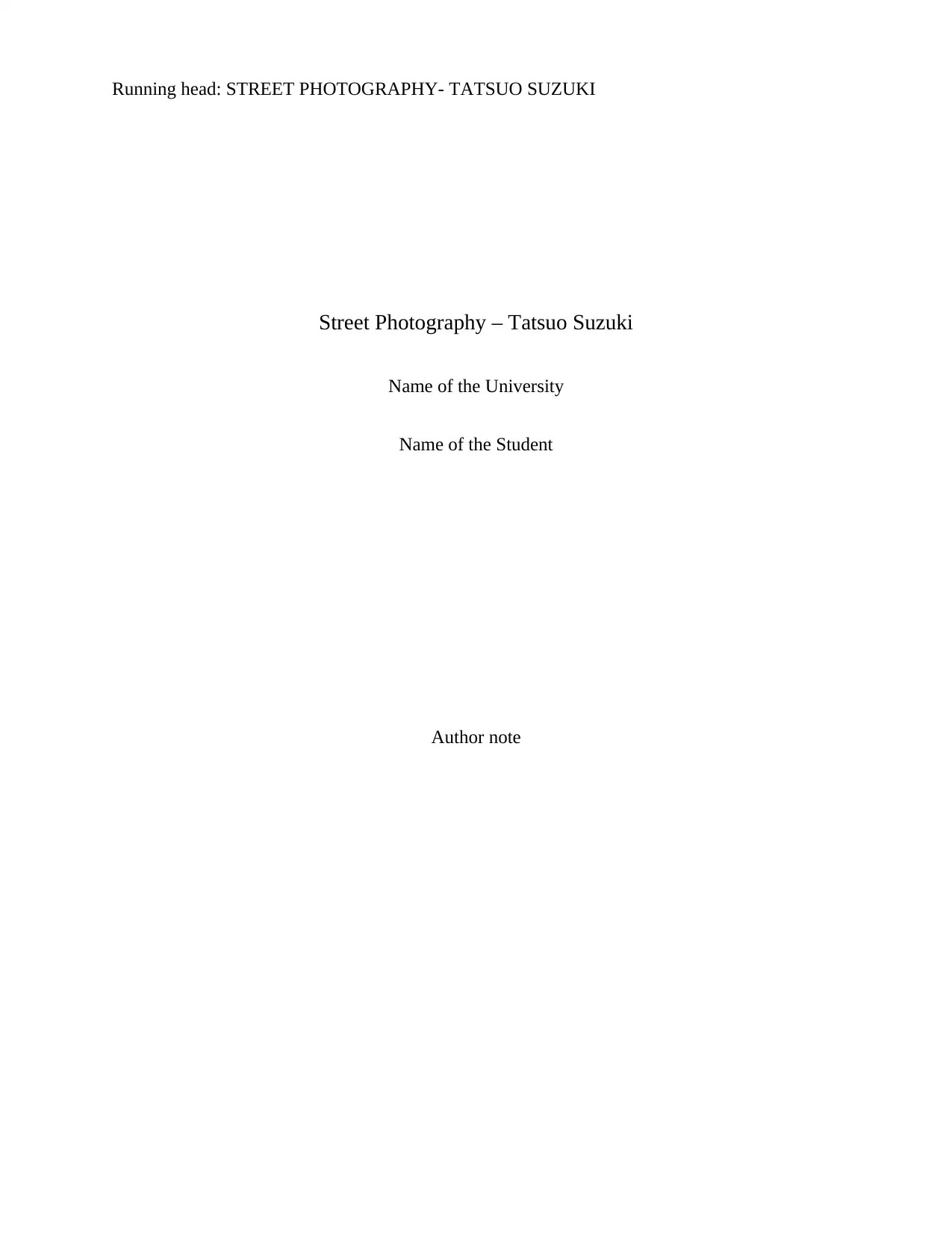
Running head: STREET PHOTOGRAPHY- TATSUO SUZUKI
Street Photography – Tatsuo Suzuki
Name of the University
Name of the Student
Author note
Street Photography – Tatsuo Suzuki
Name of the University
Name of the Student
Author note
Paraphrase This Document
Need a fresh take? Get an instant paraphrase of this document with our AI Paraphraser
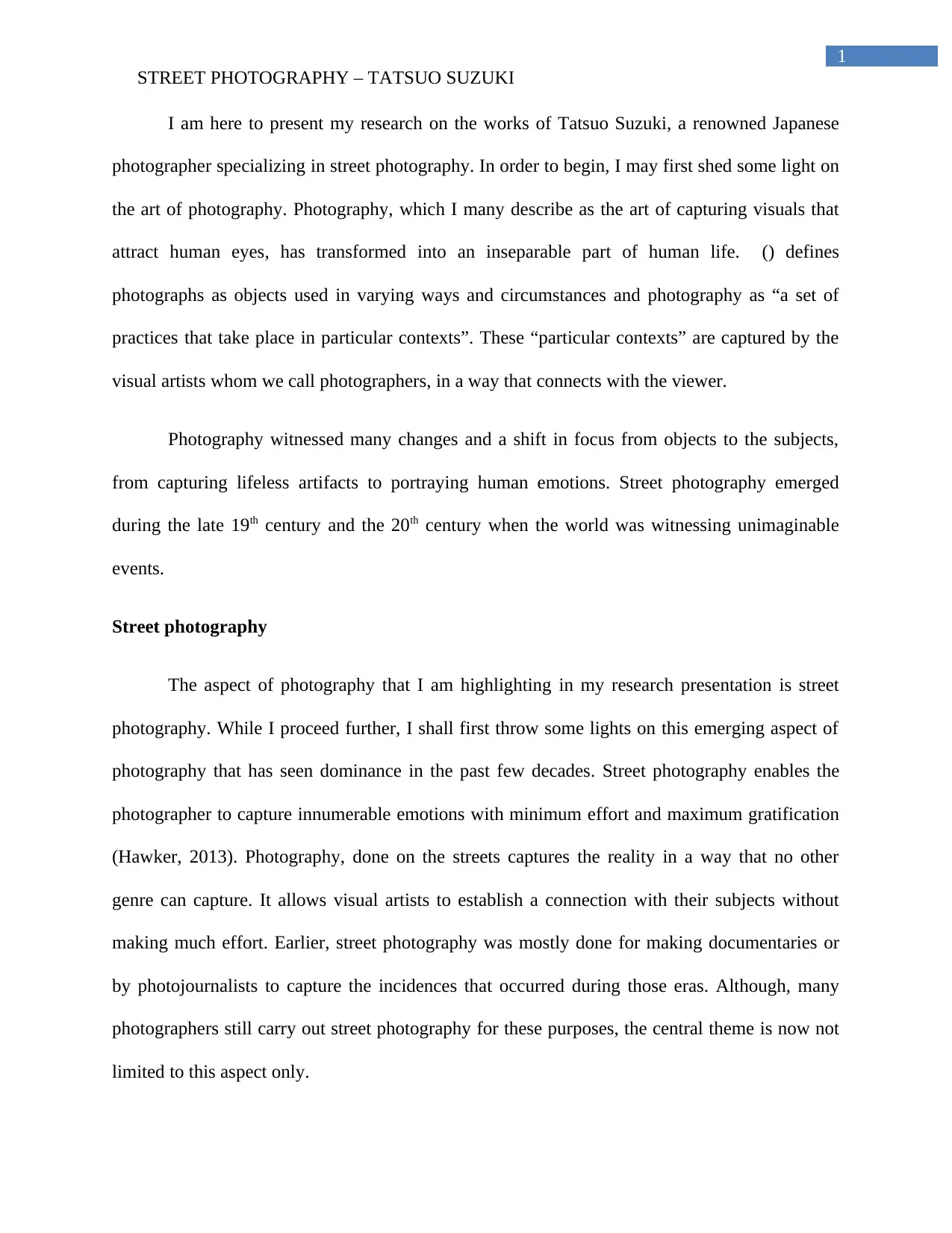
1
STREET PHOTOGRAPHY – TATSUO SUZUKI
I am here to present my research on the works of Tatsuo Suzuki, a renowned Japanese
photographer specializing in street photography. In order to begin, I may first shed some light on
the art of photography. Photography, which I many describe as the art of capturing visuals that
attract human eyes, has transformed into an inseparable part of human life. () defines
photographs as objects used in varying ways and circumstances and photography as “a set of
practices that take place in particular contexts”. These “particular contexts” are captured by the
visual artists whom we call photographers, in a way that connects with the viewer.
Photography witnessed many changes and a shift in focus from objects to the subjects,
from capturing lifeless artifacts to portraying human emotions. Street photography emerged
during the late 19th century and the 20th century when the world was witnessing unimaginable
events.
Street photography
The aspect of photography that I am highlighting in my research presentation is street
photography. While I proceed further, I shall first throw some lights on this emerging aspect of
photography that has seen dominance in the past few decades. Street photography enables the
photographer to capture innumerable emotions with minimum effort and maximum gratification
(Hawker, 2013). Photography, done on the streets captures the reality in a way that no other
genre can capture. It allows visual artists to establish a connection with their subjects without
making much effort. Earlier, street photography was mostly done for making documentaries or
by photojournalists to capture the incidences that occurred during those eras. Although, many
photographers still carry out street photography for these purposes, the central theme is now not
limited to this aspect only.
STREET PHOTOGRAPHY – TATSUO SUZUKI
I am here to present my research on the works of Tatsuo Suzuki, a renowned Japanese
photographer specializing in street photography. In order to begin, I may first shed some light on
the art of photography. Photography, which I many describe as the art of capturing visuals that
attract human eyes, has transformed into an inseparable part of human life. () defines
photographs as objects used in varying ways and circumstances and photography as “a set of
practices that take place in particular contexts”. These “particular contexts” are captured by the
visual artists whom we call photographers, in a way that connects with the viewer.
Photography witnessed many changes and a shift in focus from objects to the subjects,
from capturing lifeless artifacts to portraying human emotions. Street photography emerged
during the late 19th century and the 20th century when the world was witnessing unimaginable
events.
Street photography
The aspect of photography that I am highlighting in my research presentation is street
photography. While I proceed further, I shall first throw some lights on this emerging aspect of
photography that has seen dominance in the past few decades. Street photography enables the
photographer to capture innumerable emotions with minimum effort and maximum gratification
(Hawker, 2013). Photography, done on the streets captures the reality in a way that no other
genre can capture. It allows visual artists to establish a connection with their subjects without
making much effort. Earlier, street photography was mostly done for making documentaries or
by photojournalists to capture the incidences that occurred during those eras. Although, many
photographers still carry out street photography for these purposes, the central theme is now not
limited to this aspect only.
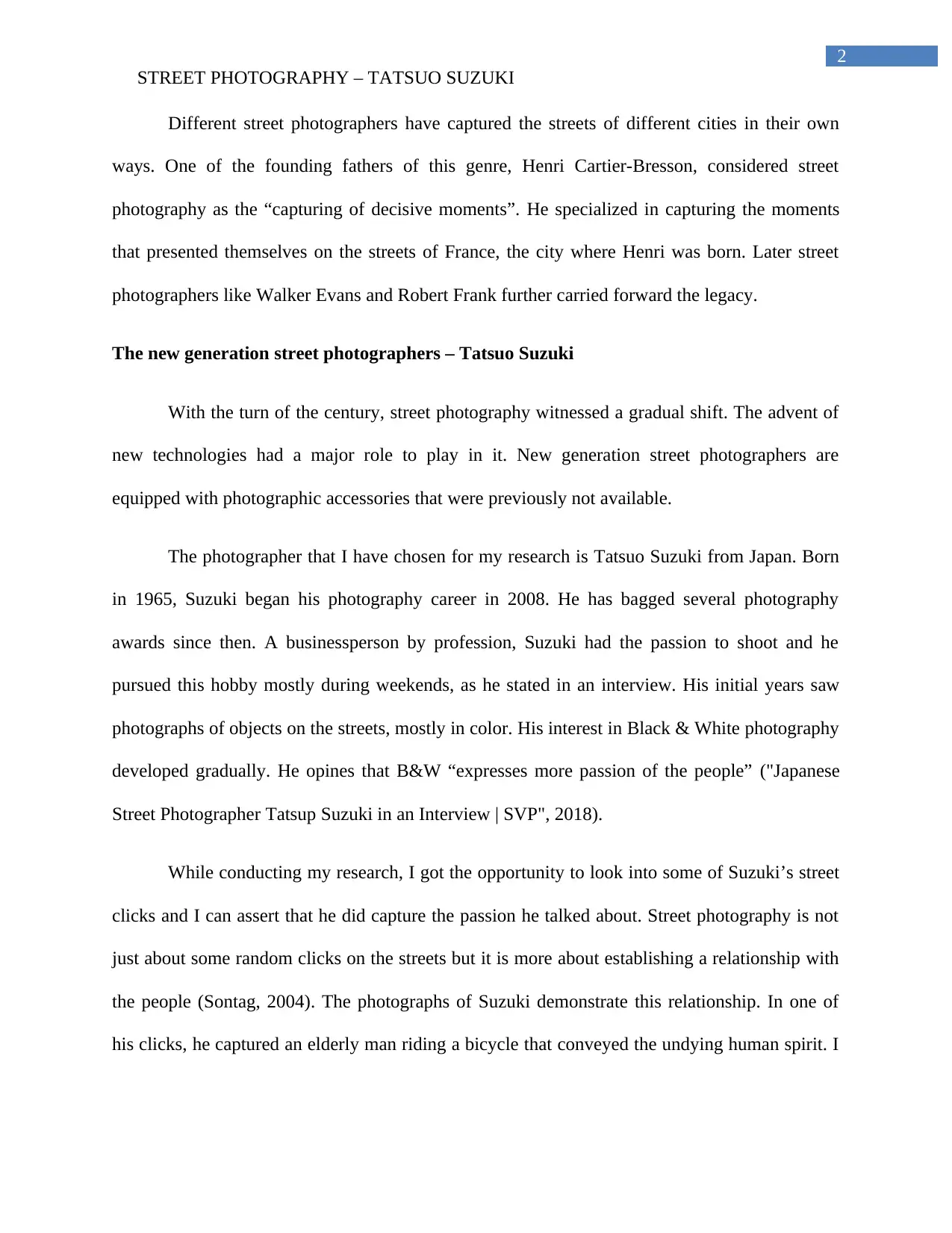
2
STREET PHOTOGRAPHY – TATSUO SUZUKI
Different street photographers have captured the streets of different cities in their own
ways. One of the founding fathers of this genre, Henri Cartier-Bresson, considered street
photography as the “capturing of decisive moments”. He specialized in capturing the moments
that presented themselves on the streets of France, the city where Henri was born. Later street
photographers like Walker Evans and Robert Frank further carried forward the legacy.
The new generation street photographers – Tatsuo Suzuki
With the turn of the century, street photography witnessed a gradual shift. The advent of
new technologies had a major role to play in it. New generation street photographers are
equipped with photographic accessories that were previously not available.
The photographer that I have chosen for my research is Tatsuo Suzuki from Japan. Born
in 1965, Suzuki began his photography career in 2008. He has bagged several photography
awards since then. A businessperson by profession, Suzuki had the passion to shoot and he
pursued this hobby mostly during weekends, as he stated in an interview. His initial years saw
photographs of objects on the streets, mostly in color. His interest in Black & White photography
developed gradually. He opines that B&W “expresses more passion of the people” ("Japanese
Street Photographer Tatsup Suzuki in an Interview | SVP", 2018).
While conducting my research, I got the opportunity to look into some of Suzuki’s street
clicks and I can assert that he did capture the passion he talked about. Street photography is not
just about some random clicks on the streets but it is more about establishing a relationship with
the people (Sontag, 2004). The photographs of Suzuki demonstrate this relationship. In one of
his clicks, he captured an elderly man riding a bicycle that conveyed the undying human spirit. I
STREET PHOTOGRAPHY – TATSUO SUZUKI
Different street photographers have captured the streets of different cities in their own
ways. One of the founding fathers of this genre, Henri Cartier-Bresson, considered street
photography as the “capturing of decisive moments”. He specialized in capturing the moments
that presented themselves on the streets of France, the city where Henri was born. Later street
photographers like Walker Evans and Robert Frank further carried forward the legacy.
The new generation street photographers – Tatsuo Suzuki
With the turn of the century, street photography witnessed a gradual shift. The advent of
new technologies had a major role to play in it. New generation street photographers are
equipped with photographic accessories that were previously not available.
The photographer that I have chosen for my research is Tatsuo Suzuki from Japan. Born
in 1965, Suzuki began his photography career in 2008. He has bagged several photography
awards since then. A businessperson by profession, Suzuki had the passion to shoot and he
pursued this hobby mostly during weekends, as he stated in an interview. His initial years saw
photographs of objects on the streets, mostly in color. His interest in Black & White photography
developed gradually. He opines that B&W “expresses more passion of the people” ("Japanese
Street Photographer Tatsup Suzuki in an Interview | SVP", 2018).
While conducting my research, I got the opportunity to look into some of Suzuki’s street
clicks and I can assert that he did capture the passion he talked about. Street photography is not
just about some random clicks on the streets but it is more about establishing a relationship with
the people (Sontag, 2004). The photographs of Suzuki demonstrate this relationship. In one of
his clicks, he captured an elderly man riding a bicycle that conveyed the undying human spirit. I
⊘ This is a preview!⊘
Do you want full access?
Subscribe today to unlock all pages.

Trusted by 1+ million students worldwide
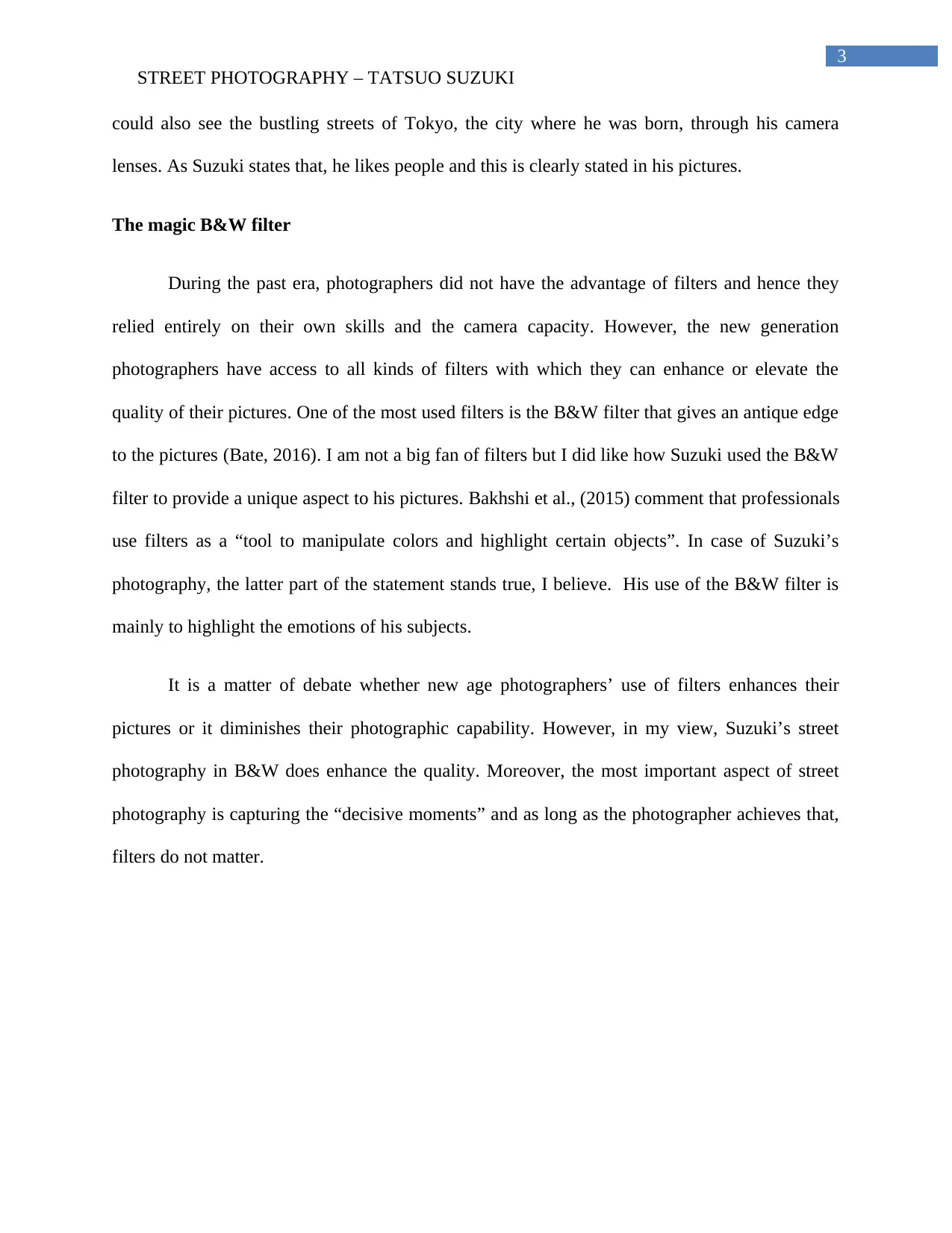
3
STREET PHOTOGRAPHY – TATSUO SUZUKI
could also see the bustling streets of Tokyo, the city where he was born, through his camera
lenses. As Suzuki states that, he likes people and this is clearly stated in his pictures.
The magic B&W filter
During the past era, photographers did not have the advantage of filters and hence they
relied entirely on their own skills and the camera capacity. However, the new generation
photographers have access to all kinds of filters with which they can enhance or elevate the
quality of their pictures. One of the most used filters is the B&W filter that gives an antique edge
to the pictures (Bate, 2016). I am not a big fan of filters but I did like how Suzuki used the B&W
filter to provide a unique aspect to his pictures. Bakhshi et al., (2015) comment that professionals
use filters as a “tool to manipulate colors and highlight certain objects”. In case of Suzuki’s
photography, the latter part of the statement stands true, I believe. His use of the B&W filter is
mainly to highlight the emotions of his subjects.
It is a matter of debate whether new age photographers’ use of filters enhances their
pictures or it diminishes their photographic capability. However, in my view, Suzuki’s street
photography in B&W does enhance the quality. Moreover, the most important aspect of street
photography is capturing the “decisive moments” and as long as the photographer achieves that,
filters do not matter.
STREET PHOTOGRAPHY – TATSUO SUZUKI
could also see the bustling streets of Tokyo, the city where he was born, through his camera
lenses. As Suzuki states that, he likes people and this is clearly stated in his pictures.
The magic B&W filter
During the past era, photographers did not have the advantage of filters and hence they
relied entirely on their own skills and the camera capacity. However, the new generation
photographers have access to all kinds of filters with which they can enhance or elevate the
quality of their pictures. One of the most used filters is the B&W filter that gives an antique edge
to the pictures (Bate, 2016). I am not a big fan of filters but I did like how Suzuki used the B&W
filter to provide a unique aspect to his pictures. Bakhshi et al., (2015) comment that professionals
use filters as a “tool to manipulate colors and highlight certain objects”. In case of Suzuki’s
photography, the latter part of the statement stands true, I believe. His use of the B&W filter is
mainly to highlight the emotions of his subjects.
It is a matter of debate whether new age photographers’ use of filters enhances their
pictures or it diminishes their photographic capability. However, in my view, Suzuki’s street
photography in B&W does enhance the quality. Moreover, the most important aspect of street
photography is capturing the “decisive moments” and as long as the photographer achieves that,
filters do not matter.
Paraphrase This Document
Need a fresh take? Get an instant paraphrase of this document with our AI Paraphraser
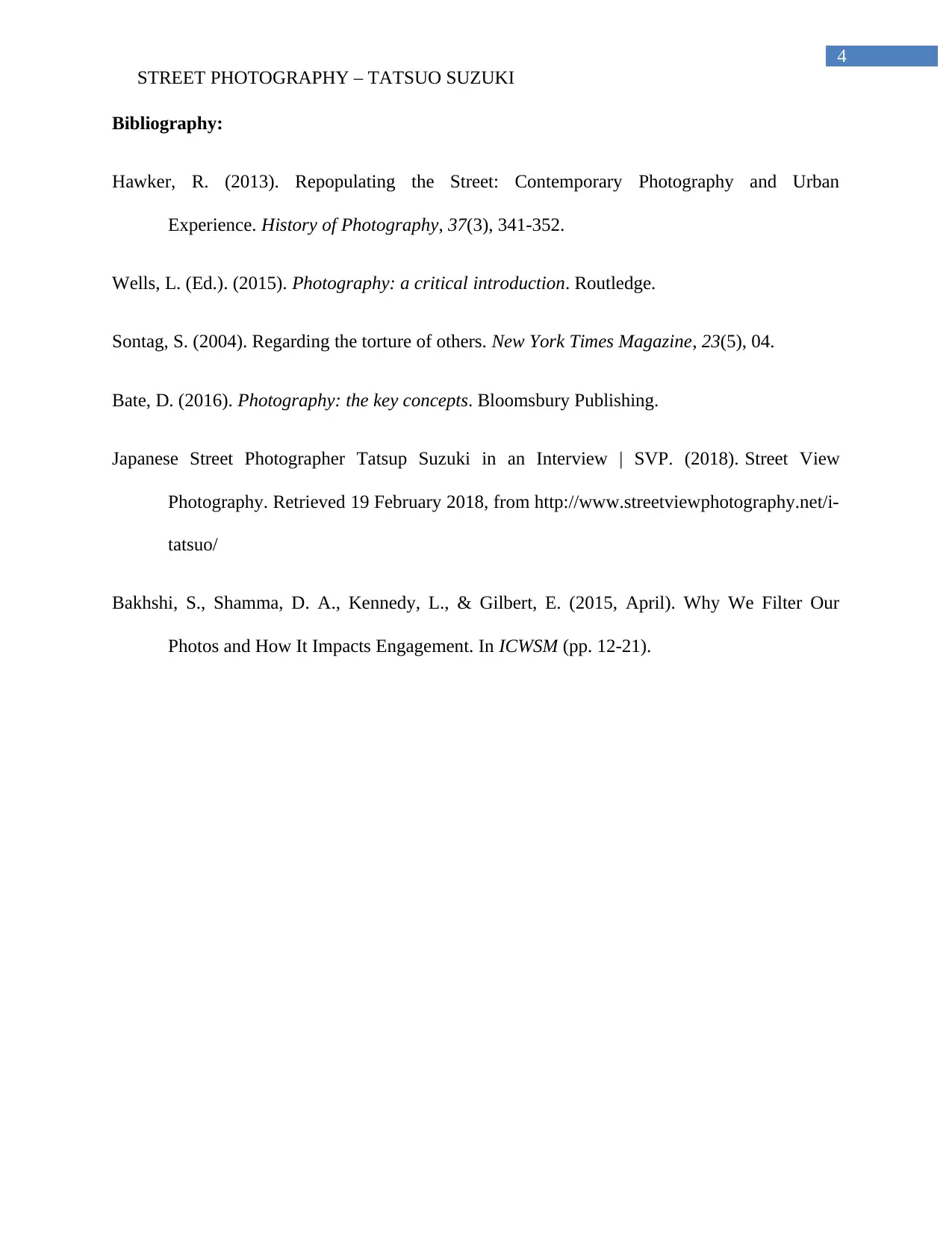
4
STREET PHOTOGRAPHY – TATSUO SUZUKI
Bibliography:
Hawker, R. (2013). Repopulating the Street: Contemporary Photography and Urban
Experience. History of Photography, 37(3), 341-352.
Wells, L. (Ed.). (2015). Photography: a critical introduction. Routledge.
Sontag, S. (2004). Regarding the torture of others. New York Times Magazine, 23(5), 04.
Bate, D. (2016). Photography: the key concepts. Bloomsbury Publishing.
Japanese Street Photographer Tatsup Suzuki in an Interview | SVP. (2018). Street View
Photography. Retrieved 19 February 2018, from http://www.streetviewphotography.net/i-
tatsuo/
Bakhshi, S., Shamma, D. A., Kennedy, L., & Gilbert, E. (2015, April). Why We Filter Our
Photos and How It Impacts Engagement. In ICWSM (pp. 12-21).
STREET PHOTOGRAPHY – TATSUO SUZUKI
Bibliography:
Hawker, R. (2013). Repopulating the Street: Contemporary Photography and Urban
Experience. History of Photography, 37(3), 341-352.
Wells, L. (Ed.). (2015). Photography: a critical introduction. Routledge.
Sontag, S. (2004). Regarding the torture of others. New York Times Magazine, 23(5), 04.
Bate, D. (2016). Photography: the key concepts. Bloomsbury Publishing.
Japanese Street Photographer Tatsup Suzuki in an Interview | SVP. (2018). Street View
Photography. Retrieved 19 February 2018, from http://www.streetviewphotography.net/i-
tatsuo/
Bakhshi, S., Shamma, D. A., Kennedy, L., & Gilbert, E. (2015, April). Why We Filter Our
Photos and How It Impacts Engagement. In ICWSM (pp. 12-21).
1 out of 5